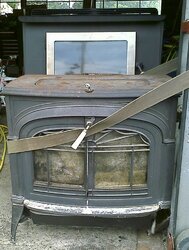wkpoor said:
I'm sure there is a myriad of reasons why the comparisons are tough to make.
Are all the new EPA stoves small in size? Most I've seen look to be half the average smoke dragon size. And that means less surface area to radiate from.
Not to belittle anything but some of the log burn times had by new stoves could be more efficient ways to smolder less wood in a smaller fire box.
I read and hear the argument for less wood consumption. However I'm thinking many are like me with an unending supply of free hardwoods so consumption rate is of no concern to me.
With all this said (and I admit a little negative sounding towards new stoves) I'm not opposed to owning a new stove. Problem with reference to original post, is you can't test drive a stove. Basically its a referral thing. However how many people after spending 2-3K on a stove are going to honestly tell you they are a little less than happy with the purchase.
This has been touched on but I'd also like to touch on it myself. The main reason is that I had some of these same misgivings before we purchased our last stove. Also, like Mr Wkpoor, we have our own woodlot so cutting and burning more wood is certainly not a big deal for us. However, I do admit that doing only half the work we used to do has some very good benefits.
As to the size of the new EPA approved stoves, you can get what you want with no problem. But most do find they can get a smaller stove and it does the job. I recall one of the first thoughts that hit me when I saw a stove like ours. My thought was, "How on earth would that little thing heat our home?" I seriously had doubts. I had also been to another home that had a very small stove and claimed it heated their huge old farmhouse very well. I doubted it.
Enter next thought: Test driving a new stove. This is exactly what we did with our stove; we test drove it. We narrowed our purchase to 2 or possibly 3 different stoves. We purchased the one we could test drive first and knew if it did not work we could quickly make a switch. We never made a switch and are very happy with our little rock of a stove. Still hard to believe this thing weighs almost 500 lbs....until you try to lift it up on a 16" raised hearth.
We've burned several different stoves over the years so we know what can be done with the old stoves. However, we try to keep an open mind and still enjoy learning. Learn we have! The very first thing we learned was that we were staying a whole lot warmer with this stove.....and then we found we were burning only half the amount of wood we used to! Nice test drive, huh?!
So I say keep your mind open rather than closing it to the newer type stoves. Yes, you will need to make sure you have perhaps better fuel than you've used in the past but by doing it, you will reap some great benefits. As stated, we use a lot less wood and we are starting our 4th season of heating with this stove. Our chimney has been cleaned one time....with less than a cup of soot and no creosote.
At the start we were also a bit closed mind with the cat type stoves because we had heard and read of some terrible experiences that people had. Then there are the so-called salesmen out there trying to sell stoves by running down other stoves; especially one that has a cat! Long story short is that we did purchase a cat stove and I fully expect if we ever buy another, it too will have a catalyst in it.
Most old folks tend to set their minds to the old ways and we do make an attempt to guard against that if at all possible. We do find that many of the new ways are indeed better than the old. It is the same with the fuel. Many older folks still think you can cut your wood in the fall and burn it that winter. I see it being done all around us here. Some just will never learn simply because they do not want to. Some just close their minds because what they know is all there is to know.
Another point is how the heat "feel" to you. There is a big difference between how the heat feels coming from a steel, cast or soapstone stove. I kept reading and hearing about this "soft heat" from a soapstone stove. Naturally, I thought Bull! Heat is heat. Now with a little more experience, I understand and can feel a definite difference and yes, it is a soft heat from a soapstone stove. It makes us very, very happy.



